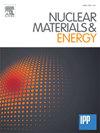Dependence of irradiation defects evolution on dose rate and PKA energy spectrum in tungsten
IF 2.7
2区 物理与天体物理
Q1 NUCLEAR SCIENCE & TECHNOLOGY
引用次数: 0
Abstract
Heavy-ion irradiation is considered as an effective method to study the performance of nuclear materials under neutron irradiation, while these two types of experiments show the striking difference in microstructure evolution and thermo-mechanical properties. In this work, taking tungsten (W) as an example, we systematically investigated how dose rate and primary knock-on atom (PKA) energy spectrum affect the evolution of displacement damages in materials using object kinetic Monte Carlo (OKMC) method. It is found that the increase of dose rate promotes the nucleation of vacancy clusters and dislocation loops but inhibits their growth, which is in agreement with the experimental results. This should be attributed to shortened evolution time, which suppresses the migration and dissociation of defects and promotes their nucleation, which can be compensated by the increase of temperature. Accordingly, a modified predictive model has been proposed to characterize the compensatory effect of temperature on different dose rates. However, different from the dose rate, the influence of PKA energy spectrum cannot be compensated by temperature variation, because the high-energy PKAs may generate large and stable defect clusters directly during collision cascade. These results clarify the influence of dose rate and PKA energy spectrum on the evolution of displacement defects in W, and provide valuable insights for assessing the performance of materials under neutron irradiation.
钨辐照缺陷演变与剂量率和PKA能谱的关系
重离子辐照被认为是研究中子辐照下核材料性能的有效方法,但这两种实验在微观结构演变和热力学性能上存在显著差异。本文以钨(W)为例,采用物体动力学蒙特卡罗(OKMC)方法,系统研究了剂量率和初级敲原子(PKA)能谱对材料位移损伤演化的影响。发现剂量率的增加促进了空位团簇和位错环的成核,但抑制了它们的生长,这与实验结果一致。这可能是由于演化时间的缩短,抑制了缺陷的迁移和解离,促进了缺陷的成核,这可以通过温度的升高来补偿。因此,提出了一个修正的预测模型来表征温度对不同剂量率的补偿效应。然而,与剂量率不同的是,PKA能谱的影响不能通过温度变化来补偿,因为高能PKA在碰撞级联过程中可以直接产生大而稳定的缺陷团簇。这些结果阐明了剂量率和PKA能谱对W中位移缺陷演变的影响,为评价材料在中子辐照下的性能提供了有价值的见解。
本文章由计算机程序翻译,如有差异,请以英文原文为准。
求助全文
约1分钟内获得全文
求助全文
来源期刊

Nuclear Materials and Energy
Materials Science-Materials Science (miscellaneous)
CiteScore
3.70
自引率
15.40%
发文量
175
审稿时长
20 weeks
期刊介绍:
The open-access journal Nuclear Materials and Energy is devoted to the growing field of research for material application in the production of nuclear energy. Nuclear Materials and Energy publishes original research articles of up to 6 pages in length.
 求助内容:
求助内容: 应助结果提醒方式:
应助结果提醒方式:


